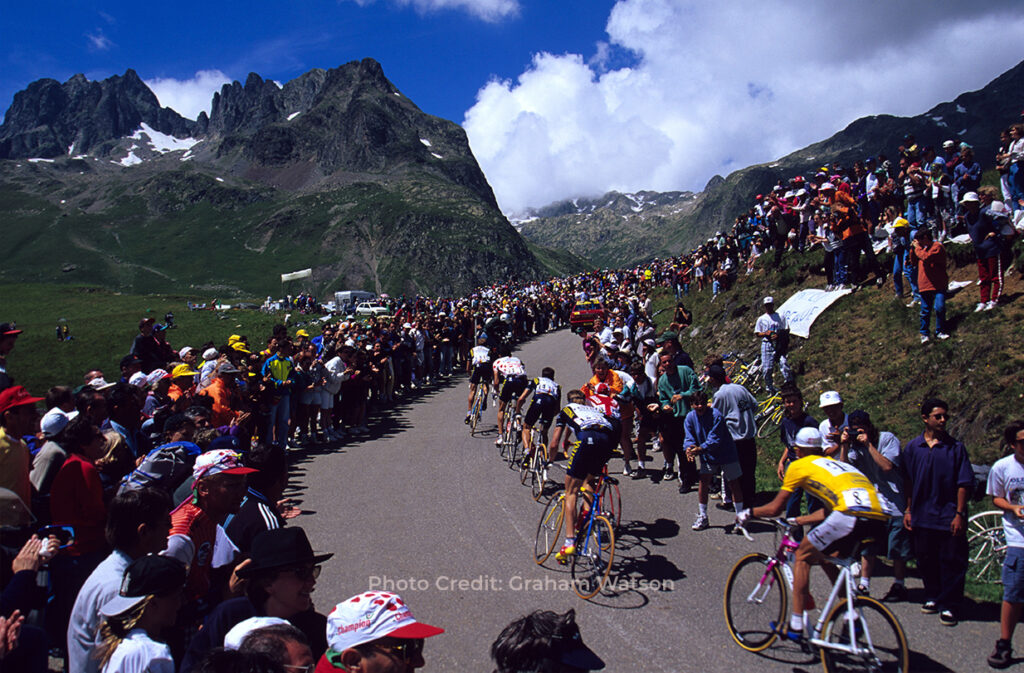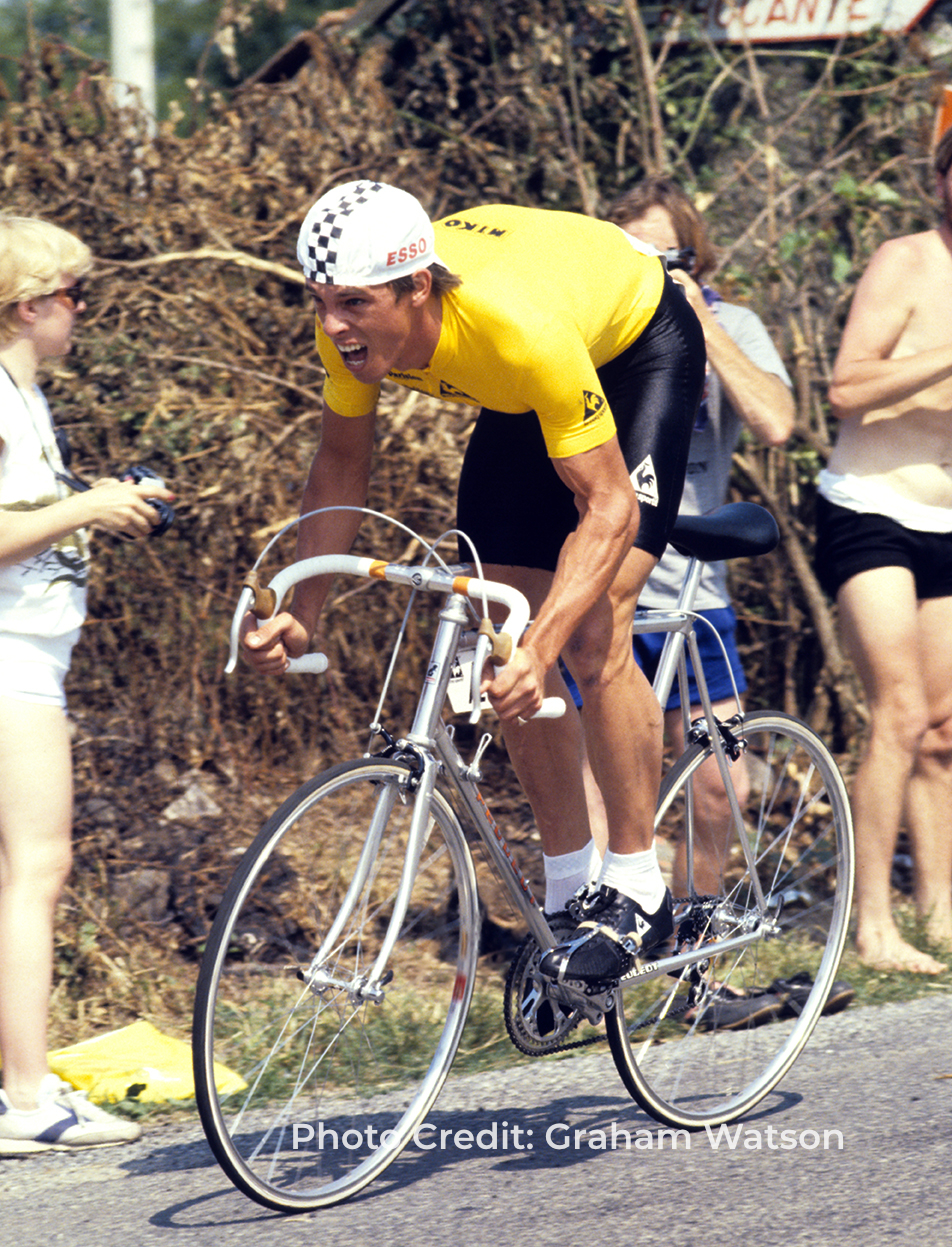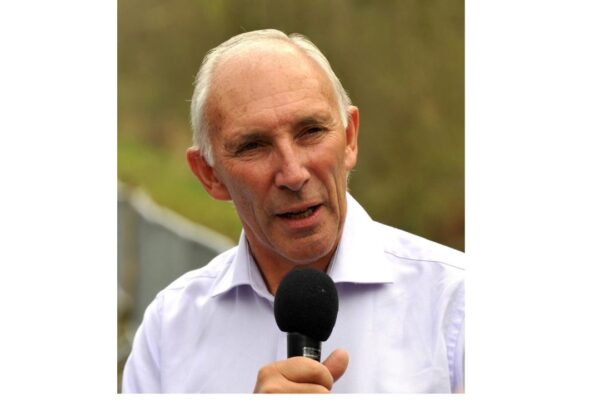Commentating legend, Phil Liggett, is rightly considered the “Voice of Cycling,” after a 40-year photography career where he captured majestic images that donned the front pages of cycling magazines the world over, Graham Watson can be considered the “Eyes of Cycling.”
In 2017 Graham, aged 60, retired from chasing and photographing the professional peloton and has happily relocated to New Zealand where he is enjoying the “next phase” of his life, as he so eloquently describes it.
We connected to discuss his career which has spanned four decades where he has witnessed the evolution of the sport, seeing the greatest riders and capturing their pivotal moments in a way that no other possibly has.
Early career
Interestingly, Graham did not start off as a cycling photographer. After leaving school at 16 years old, he worked in a London based studio, run by famous photographer Lenare, who specialised in society photography, with a focus on portraits. It was whilst working there, from the period of 1972-77 that Graham learned the skills he would rely upon, such as composition, lighting and exposure. Living in Croydon, which is 10 miles or 16 kilometres from the centre of London, Graham bought a bike to commute to work, realising it was more economical than the daily return train fare.
This commute ignited his passion for cycling and when in 1977 the studio closed, he went to Paris, with his camera to see the Tour de France, in the hope of getting an image or two of the great Eddy Merckx.
It was during his first trip, that he successfully captured Eddy Merckx in action, on the Champs Elysees. This image saw him win a prize in what is now the Cycling Weekly magazine. As Graham noted “I got £35, which was a lot of money then.”
From that moment, Graham explained “it snowballed and soon I was the only English-speaking photographer that covered all the races. I had clients in the UK, USA, Australia, and people were coming to me for pictures.”
Pioneering cycling photography
In 1980, Graham photographed the “Queen of the Classics,” Paris-Roubaix, for the first time. To complete this undertaking required unprecedented commitment. Graham retold the story. “I drove to Dover and caught the ferry to Calais, arriving early in the morning. I then rode 75 miles to the outskirts of Roubaix, roughly 15km from the finish and I waited for the riders. I took my pictures and rode the 75 miles back to the ferry in the dark, taking between 3 to 4 hours.” This story highlights Graham’s dedication to his craft and getting that all-important image.

In his quest to capture new and dynamic pictures, 1982 Graham connected with the Race Organisers from the Tour of Flanders to discuss the opportunity of taking photos from the back of a motorbike. They agreed, realising the excellent marketing opportunity that this represented. Soon, other Race Organisers followed suite and in 1987 Graham covered Paris-Roubaix in the same way.
A few months later, and exactly 10 years following his first ever visit to the Tour de France, Graham found himself on the back of a motorbike at the Tour, where he found himself up close and personal with the peloton, capturing unique imagines of the Tour in a way never previously done. This became his familiar position, until his final Tour in 2016.
His innovative approach to photography was pioneering and he helped forge the path that others now follow.
View from the Motorbike
He has covered every possible race, but it’s not the Tour de France which is his favourite, with the modern Tour being as he describes “One of the more stressful events to cover due to the volume of people, it’s like being in the Colosseum for 7 hours a day. You are part of the race and it can be nervous at times and there is also the pressure to get the shot, where you may only have one chance.” I can empathise, as Graham, was often forced to keep pace with the riders on narrow mountain descents, at speeds reaching 100kmph. “Don’t get me wrong”, he says, “the Tour is a thrilling experience, it is the biggest and best race of them all, and it is an absolute privilege being part of it.”
Similarly, capturing images during the Tour of Flander and Paris-Roubaix became more difficult and due to the road conditions and volume of spectators that come to watch these historic races in the 2000’s. In addition, there was the added anxiety that came with getting into the right position, to capture the action.
When Graham started following the races on the back of a moto in the early-80’s it was a much quieter affair with thousands, but not tens of thousands, lining the race-routes. “As glamorous and exciting as today’s races are, I much preferred those older days when I could shoot my images without too much challenge and enjoy the racing at the same time, that goes for both the one-day Classics and Grand Tours,” he says.
Instead of the Grand Tours, it was the smaller races such as the Tour of Romandie and Tour of Switzerland which were Graham’s favourite races to cover.

The Tour of Romandie, comes after a month of the toughest Classics in the sport, where stress levels in the peloton are at their highest, Graham observed that; “By comparison, Romandie is like a quiet five-day ‘holiday’ in the most peaceful and beautiful part of the world, and a race in which just a few photographers get involved, so the road and the scenery is almost my own. Romandie also acts as a calming delight between the Classics and the start of the Giro, a chance to recharge the batteries and take a breath.”

Similarly, the Tour of Switzerland is another week-long race that comes after the Giro d’Italia and before the start of the Tour, allowing Graham a period of relative tranquillity. “The Swiss Alps are still coated with snow, the valleys are a rich green, and the cyclists seem to be happier here than anywhere else the whole season. Such rewarding photography to be had.”
Reflections
In January 2017, Graham photographed his last race, the Tour Down Under, retiring after 45-years as a photographer, 38 of which was spent chasing the peloton. During that time, he photographed the greats of the sport, such as include; Bernard Hinault, Laurent Fignon, Greg Lemond, Stephen Roche, Robert Millar, Sean Kelly, Mario Cipollini, Miguel Indurain, Tony Rominger, Jan Ullrich, Chris Boardman, Marco Pantani, Paolo Bettini, Tom Boonen, Fabian Cancellara, Cadel Evans, Philippe Gilbert, Mark Cavendish, Alberto Contador, Bradley Wiggins, Alejandro Valverde, Vincenzo Nibali and Chris Froome.
His favourite image and his most famous is that of Bernard Hinault and Greg LeMond racing together to the summit of L’Alpe d’Huez in the 1986 Tour de France. This is because as Graham explained “technically it was perfect, like the old studio portraits I’d been trained to capture. They were two gladiators and the picture captures both their pain and elation and it’s still my most satisfying picture ever taken.”

Given that Graham found himself in some very unique positions during his career, he noted that that his most significant photo was that of Phil Anderson, who was the first non-European to wear the yellow jersey of the Tour de France, in 1981. Graham described the moment.
“Phil Anderson had taken on Bernard Hinault at Pla d’Adet in 1981 and jumped into the yellow jersey. I knew it was a pivotal moment and that a decent shot of Phil in yellow the next day was obligatory. It was a TT, as simple as, and I had chosen my overnight camp-stop to be in the best location to get what I assumed was a one-chance image, as Hinault would surely take the race lead in the TT. I ended up with an unremarkable image of a remarkable cyclist, but it’s importance soon became obvious.
The undeveloped rolls of film went to London and that image of Phil ended up on one of the earlier full-colour covers of Cycling Weekly. Even before I’d finished that Tour and got back to London, an American publication wanted to use in on their cover. So I rescued the slide from CW and couriered it to the USA, but even before I’d seen a copy of that magazine an Australian publisher wanted to use it.
Hinault had gone on to win the Tour, but Phil’s single day in yellow had made headline news around the world, and I seemed to be the only photographer with a quality colour slide of it. That image of Phil was heading for the cover of a brand-new magazine called Bicycling Australia – they were launching it because of Phil’s ascension into the yellow jersey.
The worrying thing for me was that my precious slide was flying around the world, being passed on by couriers to editors and printers, each and every step of the process likely to damage the slide or see it lost along the way. Eventually, and we were still in an era where film-scanners didn’t exist, I was able to keep hold of it long enough to make duplicates to at least have some fallback if the worst case scenario happened. That single image of Phil in yellow continues to be published today, and I am always reminded of the significant advance it made to my burgeoning career in the early-1980’s.”

Graham was literally, front and centre and capturing history as it was being written.
With a list of true greats in his album, the best athlete that Graham has photographed is Sean Kelly but notes that Wout Van Aert is a “true all-rounder – he sprints, time trials, climbs, and even runs before or after a race on occasions!”
Retirement
Asked what he misses since retiring, Graham was clear, “I miss the lifestyle and the daily surprises that come with constant travel – but not the work.”
One of the ‘challenges’ that Graham refers to is that of logistics. In the early years, he undertook what is now termed ‘Cycle Touring.’ He would follow the race with his bike and camp enroute, later staying in Youth Hostels and in the 1990s, hotels. This was pre-internet, which made life complicated as he explained “I had a guide book and would call up the hotels and, in some cases, write to them and they would write back, but quite a few things went wrong, such as with reservations.” In the early-80’s, he would take his bike and put in his car, drive close to where the action would be and then ride with camera in a handlebar bag, to find the best position to get a photograph, where he would have one chance per day, to get that perfect image.
Innovations
Graham has witnessed firsthand the evolution of cycling over a period of 40 years, the biggest innovation that he has seen has been the introduction of cleats back in 1985/86. “Cleats, improved pedalling efficiency – basically everyone rode faster.” Other innovations that Graham has witnessed include the introduction of helmets, carbon frames and most recently, electric gear shifting, as well as the use of team radios, which has shaped modern races.

From a photography point of view, it has been the introduction of the digital camera that has impacted his work, allowing images to be captured and sent instantly to print. Prior to that, getting the photographs to where they needed to be was a difficult process as Graham detailed. “I used to shoot black and white and then colour slide, and get the pictures developed as and when I could, often working through the night to select several sets of images of a race and then courier them to London or New York or Brussels – my undeveloped slide-film went on Concorde during the 1987 Tour.” Graham noted that this process “happened each and every day for three weeks. They’d first go to Paris with the daily despatch of drug-tests, post and other items flown by the Tour’s private plane. A local courier then picked up the package and put it on the morning’s flight to end up at the Sports Illustrated offices. They ended up using just six images of the entire race, at a cost of I don’t know what!”
Summing Up
Graham’s photographs are not just simple images of cyclists, when his work is viewed in its entirety, it documents the history of the sport over a 40-year period, he was literally front and centre, recording history as it unfolded. Through skill, experience and a deep understanding of the sport, he was always on hand to record these key moments. Even though Graham has now retired, his images are everlasting and are used by magazines and Event Organisers around the world, meaning despite his retirement, Graham is still ever present in the cycling world where he has quite literally been the “Eyes of Cycling.”
To buy images seen in this article, visit https://photos.grahamwatson.com/Print-Gallery


